Abstract
We have shown previously that normal B cells share, with Epstein-Barr virus-transformed and malignant B cells, the ability to activate the alternative pathway (AP) of complement in vitro, resulting in the deposition of C3 fragments on the cell surface. Complement receptor type 2 (CR2, CD21) has been implicated directly as the site for formation of an AP convertase, which provides nascent C3b for deposition at secondary sites on the B-cell surface. In the present study, we have examined C3 fragment deposition in vitro in more detail by (1) assessing the importance of locally generated C3b for the deposition process, (2) investigating whether CR2 is the sole requirement for conferring AP activation capacity on a cell, and (3) determining whether CR2's function, as an AP activator, has different structural requirements from ligand binding. Increasing the availability of native C3, by increasing the serum (NHS) concentration, resulted in enhanced C3 fragment deposition on the B cells, whereas use of factor 1-depleted NHS, which showed massive fluid phase C3 conversion during the incubation, diminished the deposition. Sodium dodecyl sulphate-polyacrylamide gel electrophoresis (SDS-PAGE) and Western blotting of untreated and hydroxylamine-treated lysates from B cells, after in vitro activation, revealed that the majority of C3 fragments (primarily iC3b and C3dg) had been covalently bound to the cell surface. Transfection of COS cells with wild-type CR2 or a deletion mutant lacking 11 of the molecule's 15 homologous domains, but retaining the ligand-binding site, revealed that expression of intact CR2 conferred a 12-fold increase in AP-activating capacity on these cells, while no increase in AP activity was apparent on cells transfected with the mutant CR2.
Full text
PDF

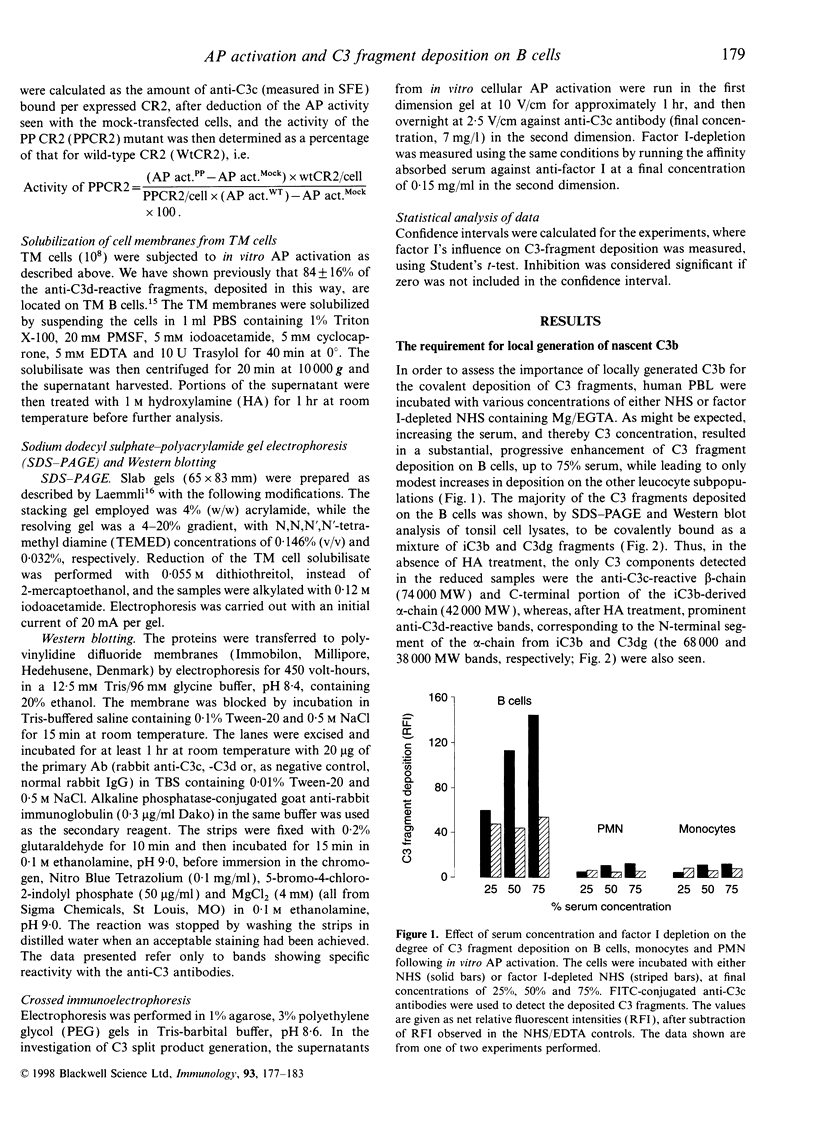
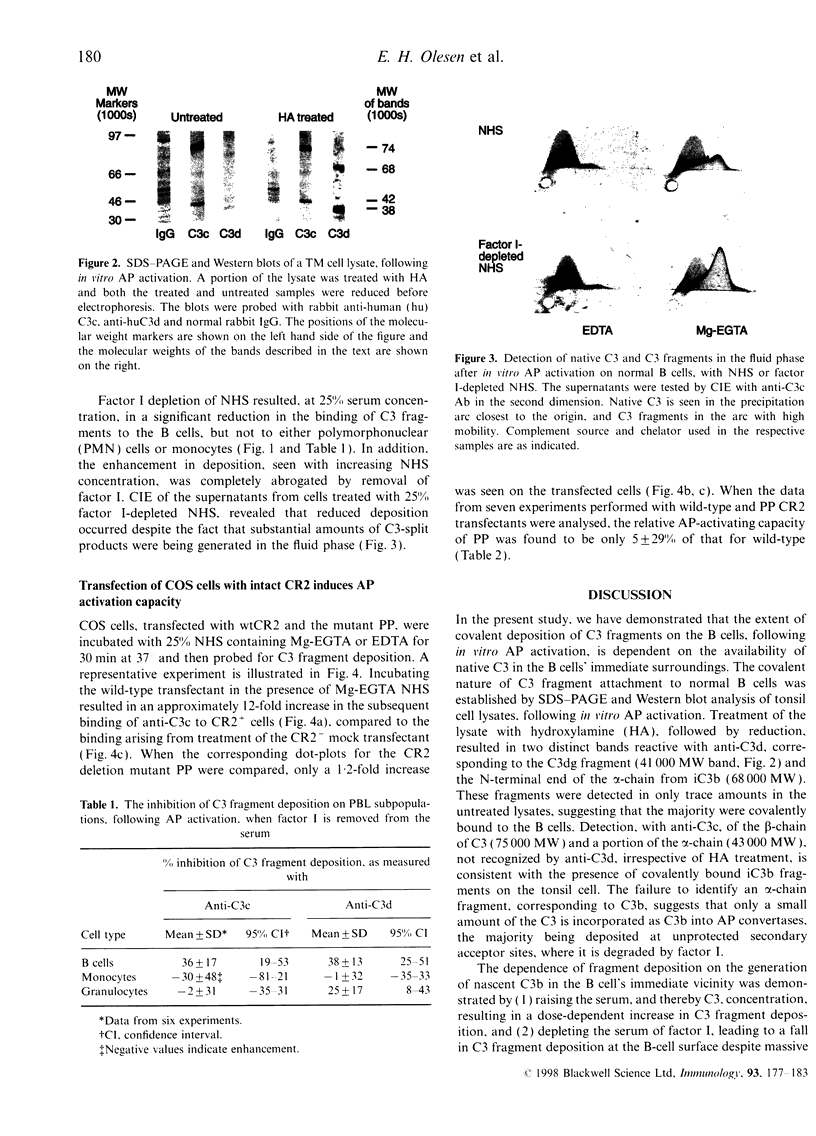
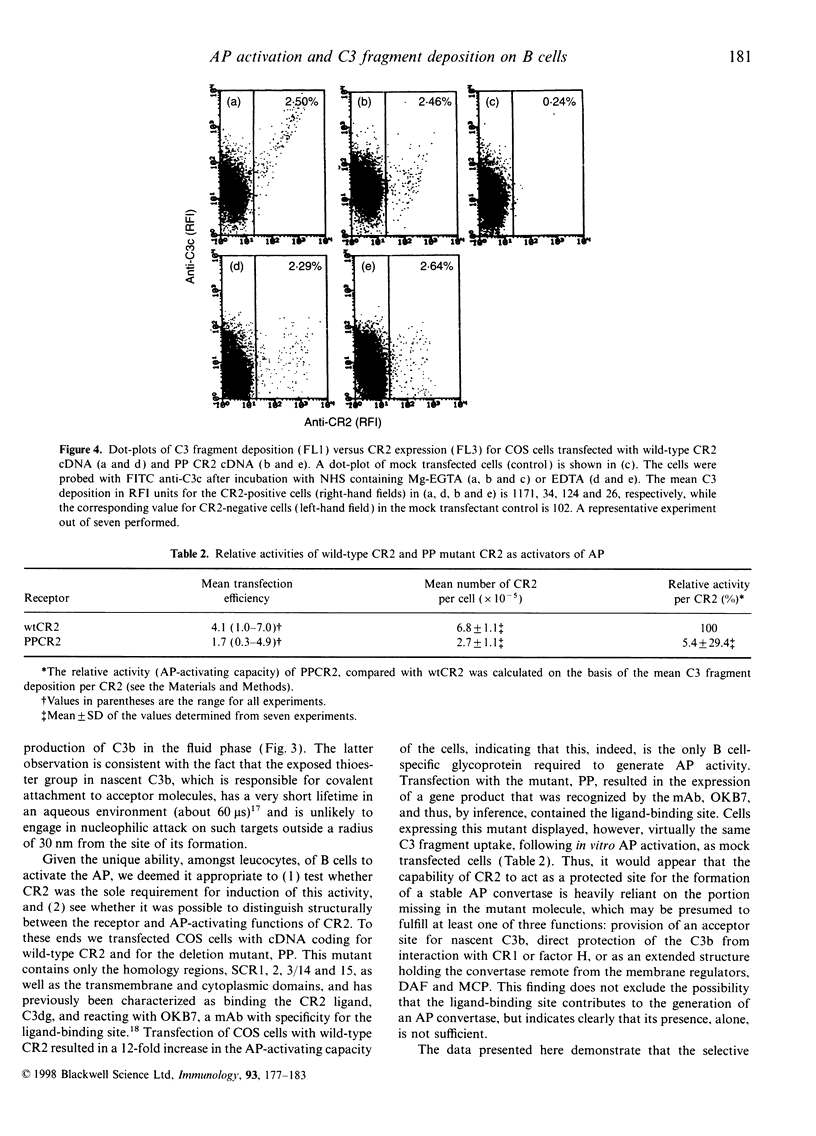
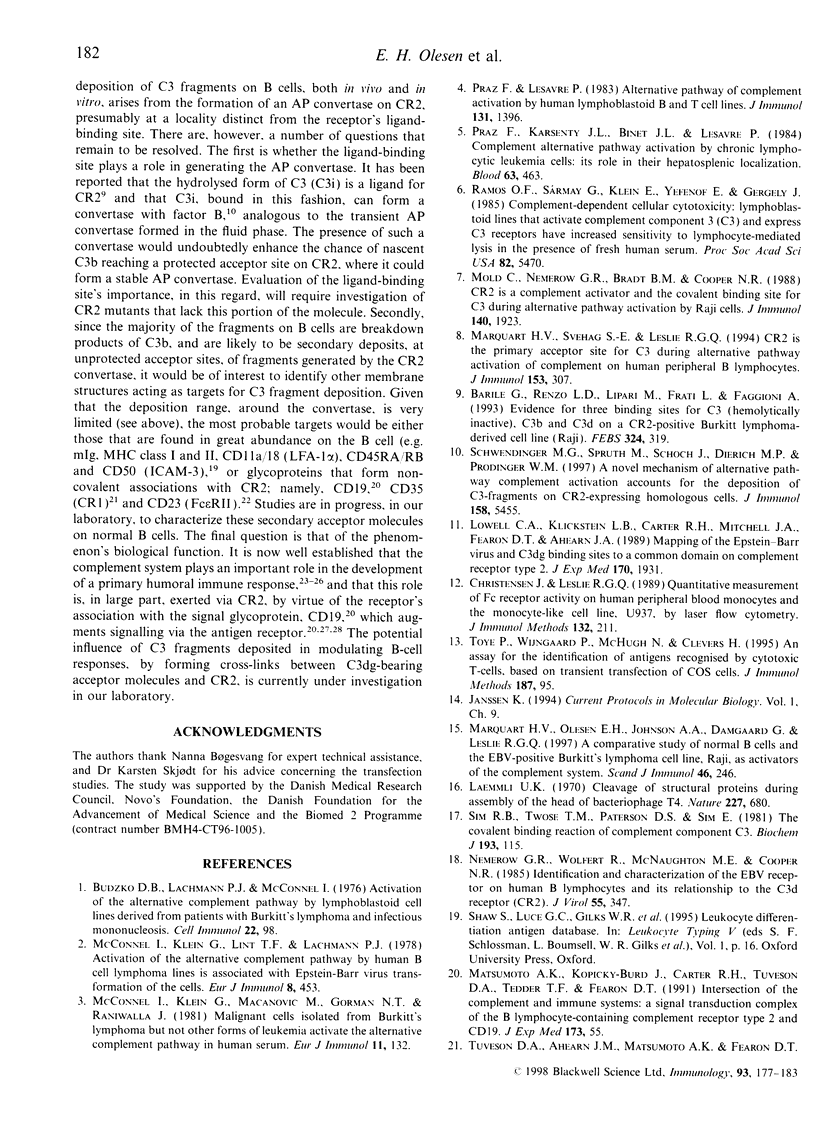
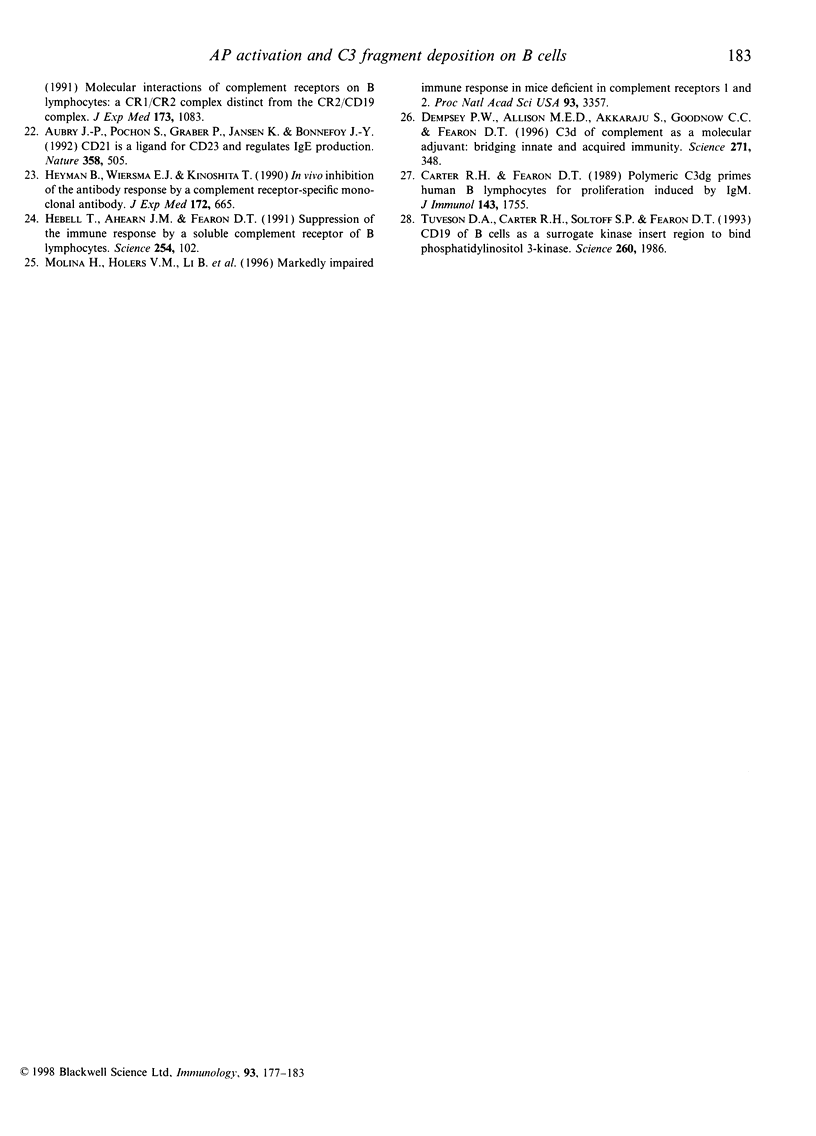
Images in this article
Selected References
These references are in PubMed. This may not be the complete list of references from this article.
- Aubry J. P., Pochon S., Graber P., Jansen K. U., Bonnefoy J. Y. CD21 is a ligand for CD23 and regulates IgE production. Nature. 1992 Aug 6;358(6386):505–507. doi: 10.1038/358505a0. [DOI] [PubMed] [Google Scholar]
- Barile G., Di Renzo L., Lipari M., Frati L., Faggioni A. Evidence for three binding sites for C3 (hemolytically inactive), C3b and C3d on a CR2-positive Burkitt lymphoma-derived cell line (Raji). FEBS Lett. 1993 Jun 21;324(3):319–324. doi: 10.1016/0014-5793(93)80143-i. [DOI] [PubMed] [Google Scholar]
- Budzko D. B., Lachmann P. J., McConnell I. Activation of the alternative complement pathway by lymphoblastoid cell lines derived from patients with Burkitt's lymphoma and infectious mononucleosis. Cell Immunol. 1976 Mar 1;22(1):98–109. doi: 10.1016/0008-8749(76)90011-3. [DOI] [PubMed] [Google Scholar]
- Carter R. H., Fearon D. T. Polymeric C3dg primes human B lymphocytes for proliferation induced by anti-IgM. J Immunol. 1989 Sep 15;143(6):1755–1760. [PubMed] [Google Scholar]
- Dempsey P. W., Allison M. E., Akkaraju S., Goodnow C. C., Fearon D. T. C3d of complement as a molecular adjuvant: bridging innate and acquired immunity. Science. 1996 Jan 19;271(5247):348–350. doi: 10.1126/science.271.5247.348. [DOI] [PubMed] [Google Scholar]
- Hebell T., Ahearn J. M., Fearon D. T. Suppression of the immune response by a soluble complement receptor of B lymphocytes. Science. 1991 Oct 4;254(5028):102–105. doi: 10.1126/science.1718035. [DOI] [PubMed] [Google Scholar]
- Heyman B., Wiersma E. J., Kinoshita T. In vivo inhibition of the antibody response by a complement receptor-specific monoclonal antibody. J Exp Med. 1990 Aug 1;172(2):665–668. doi: 10.1084/jem.172.2.665. [DOI] [PMC free article] [PubMed] [Google Scholar]
- Laemmli U. K. Cleavage of structural proteins during the assembly of the head of bacteriophage T4. Nature. 1970 Aug 15;227(5259):680–685. doi: 10.1038/227680a0. [DOI] [PubMed] [Google Scholar]
- Lowell C. A., Klickstein L. B., Carter R. H., Mitchell J. A., Fearon D. T., Ahearn J. M. Mapping of the Epstein-Barr virus and C3dg binding sites to a common domain on complement receptor type 2. J Exp Med. 1989 Dec 1;170(6):1931–1946. doi: 10.1084/jem.170.6.1931. [DOI] [PMC free article] [PubMed] [Google Scholar]
- Marquart H. V., Olesen E. H., Johnson A. A., Damgaard G., Leslie R. G. A comparative study of normal B cells and the EBV-positive Burkitt's lymphoma cell line, Raji, as activators of the complement system. Scand J Immunol. 1997 Sep;46(3):246–253. doi: 10.1046/j.1365-3083.1997.d01-122.x. [DOI] [PubMed] [Google Scholar]
- Marquart H. V., Svehag S. E., Leslie R. G. CR2 is the primary acceptor site for C3 during alternative pathway activation of complement on human peripheral B lymphocytes. J Immunol. 1994 Jul 1;153(1):307–315. [PubMed] [Google Scholar]
- McConnell I., Klein G., Lint T. F., Lachmann P. J. Activation of the alternative complement pathway by human B cell lymphoma lines is associated with Epstein-Barr virus transformation of the cells. Eur J Immunol. 1978 Jul;8(7):453–458. doi: 10.1002/eji.1830080702. [DOI] [PubMed] [Google Scholar]
- McConnell I., Klein G., Macanovic M., Gorman N. T., Raniwalla J. Malignant cells isolated from Burkitt's lymphoma but not other forms of leukemia activate the alternative complement pathway in human serum. Eur J Immunol. 1981 Feb;11(2):132–135. doi: 10.1002/eji.1830110213. [DOI] [PubMed] [Google Scholar]
- Mold C., Nemerow G. R., Bradt B. M., Cooper N. R. CR2 is a complement activator and the covalent binding site for C3 during alternative pathway activation by Raji cells. J Immunol. 1988 Mar 15;140(6):1923–1929. [PubMed] [Google Scholar]
- Molina H., Holers V. M., Li B., Fung Y., Mariathasan S., Goellner J., Strauss-Schoenberger J., Karr R. W., Chaplin D. D. Markedly impaired humoral immune response in mice deficient in complement receptors 1 and 2. Proc Natl Acad Sci U S A. 1996 Apr 16;93(8):3357–3361. doi: 10.1073/pnas.93.8.3357. [DOI] [PMC free article] [PubMed] [Google Scholar]
- Nemerow G. R., Wolfert R., McNaughton M. E., Cooper N. R. Identification and characterization of the Epstein-Barr virus receptor on human B lymphocytes and its relationship to the C3d complement receptor (CR2). J Virol. 1985 Aug;55(2):347–351. doi: 10.1128/jvi.55.2.347-351.1985. [DOI] [PMC free article] [PubMed] [Google Scholar]
- Praz F., Karsenty G., Binet J. L., Lesavre P. Complement alternative pathway activation by chronic lymphocytic leukemia cells: its role in their hepatosplenic localization. Blood. 1984 Feb;63(2):463–467. [PubMed] [Google Scholar]
- Praz F., Lesavre P. Alternative pathway of complement activation by human lymphoblastoid B and T cell lines. J Immunol. 1983 Sep;131(3):1396–1399. [PubMed] [Google Scholar]
- Ramond P. Theoretical physics. Science. 1993 Jun 25;260(5116):1986–1986. doi: 10.1126/science.260.5116.1986. [DOI] [PubMed] [Google Scholar]
- Ramos O. F., Sármay G., Klein E., Yefenof E., Gergely J. Complement-dependent cellular cytotoxicity: lymphoblastoid lines that activate complement component 3 (C3) and express C3 receptors have increased sensitivity to lymphocyte-mediated lysis in the presence of fresh human serum. Proc Natl Acad Sci U S A. 1985 Aug;82(16):5470–5474. doi: 10.1073/pnas.82.16.5470. [DOI] [PMC free article] [PubMed] [Google Scholar]
- Schwendinger M. G., Spruth M., Schoch J., Dierich M. P., Prodinger W. M. A novel mechanism of alternative pathway complement activation accounts for the deposition of C3 fragments on CR2-expressing homologous cells. J Immunol. 1997 Jun 1;158(11):5455–5463. [PubMed] [Google Scholar]
- Sim R. B., Twose T. M., Paterson D. S., Sim E. The covalent-binding reaction of complement component C3. Biochem J. 1981 Jan 1;193(1):115–127. doi: 10.1042/bj1930115. [DOI] [PMC free article] [PubMed] [Google Scholar]




